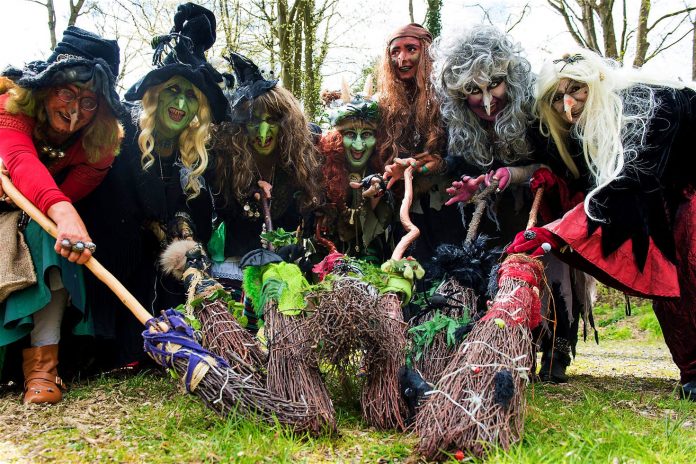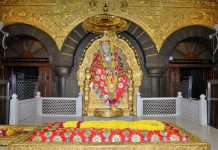Witches and witchcraft have been both hated or revered throughout human history; loved as skilled healers or feminist icons, feared as handmaidens of the devil and practicioners of mysterious dark arts. As a result, witch lore pops up all over the world and sometimes in surprising modern day incarnations. Here are 7 destinations with a rich witchy history or a thriving tradition of mystic healing.
Catemaco, Mexico
 Wizard Hector Betaza, raises a sword during a black mass as part of the annual International Congress of Witches in Catemaco (c) Ronaldo Schemidt/AFP/Getty
Wizard Hector Betaza, raises a sword during a black mass as part of the annual International Congress of Witches in Catemaco (c) Ronaldo Schemidt/AFP/Getty
Alongside Catemaco’s beautiful waterfalls and untouched beaches, the main tourist attraction is their long history of sorcery, mainly practiced by male brujos. Black and white magic are on offer throughout the year, although debate rages among locals about who is a con artist and who is an earnest practitioner of shamanic beliefs.
The exact origin of those rituals have largely stumped anthropologists but the general consensus is they’re a mix of pre-Hispanic beliefs that are now mixed up with Catholicism. Even the mayor is a brujo and heads up the annual Ritos, Ceremonias y Artesanías Mágica, a three-day event that starts on the first Friday of March with a ‘black mass’ near the town’s lake, attracting tourists and purveyors of fortunes, spells and potions.
Harz Mountains, Northern Germany
 Women dressed as witches practicing for Walpurgis night (c) Swen Pförtner/picture alliance via Getty
Women dressed as witches practicing for Walpurgis night (c) Swen Pförtner/picture alliance via Getty
The Brocken, the highest peak of the Harz mountain range has long been associated with witchcraft and legends, with some sources associating it with sacrifices to the ancient Saxon god Woden (Odin of Norse legend). The peak was also said to be the meeting point for witches on Walpurgisnacht or Hexennacht, the night of 30 April. The legend was immortalised in Goethe’s ‘Faust’ and in recent years Walpurgisnacht has made a resurgence to embrace its pagan roots, turning away from being a Christian festival to protect against witches to instead be a chance to dress up and dance with them instead.
Variations are held in various parts of Eastern Europe and Scandinavia but it remains a quintessential German tradition and Harz Mountains is the epicentre. As well as festivities on the Brocken itself, the nearby towns of Thale, Wernigerode and Goslar go all out, including a thrilling ‘storming of the city hall by witches’. The Hexentanzplatz (meaning ‘dancefloor of the witch’) is home to creepy sculptures of witches and devils all year around and, for the more botanically-inclined witch, the hiking trails are extremely popular all year round.
New Orleans, USA
 Voodoo altar at New Orleans Historic Voodoo Museum (c) Kris Davidson/Lonely Planet
Voodoo altar at New Orleans Historic Voodoo Museum (c) Kris Davidson/Lonely Planet
Forget Salem with its broomstick memorabilia, New Orleans is the real home of magic in the USA, thanks to its rich history of Voodoo. The city’s unique mix of West African spirits and Roman Catholic saints has survived since the 1700s in thanks in part to the enduring legend of Marie Laveau, a famous healer and voodoo priestess. So popular is her legacy, you can only visit her final resting place by guided tour as people still wish to mark an ‘X’ on her tomb in the hope she’ll grant their wish.
The modern practice of Voodoo is fairly limited in the city today but you can dig deeper into the history thanks to the Historic Voodoo Museum in the French Quarter or with one of the many tours. For more neo-Pagan vibes, you can pop into Hex for readings, crystals, herbs and more, with plenty of formulas inspired by West African traditions and Laveau herself.
Siquijor, Philippines
 Roots, twigs and tree barks soaked in liquid are the essential ingredients in Siquijor potions (c) John S Lander/LightRocket via Getty
Roots, twigs and tree barks soaked in liquid are the essential ingredients in Siquijor potions (c) John S Lander/LightRocket via Getty
Dubbed the ‘Island of Witches’ by Spanish colonisers in the 1600s, Siquijor still maintains a strong tradition of local healers (mananambal) and hexers (mambabarang). The mananambal throw a huge Healing Festival the week prior to Easter, the culmination of seven weeks of gathering natural ingredients every Friday during Lent. The result is the ever-popular love potions or healing herbs, while rituals and readings are also on offer.
A 400-year-old Balete tree is also a supposedly enchanted place. The oldest and biggest of its kind in the province, it’s also home to a spring that comes directly up from its tangled roots. Once said to be the home to rituals and supernatural creatures, these days, you are more likely to encounter souvenir sellers.
Blå Jungfrun Island, Sweden
 Blå Jungfrun is said to be the real-time counterpart of Blåkulla (c) Gustaf Emanuelsson / Folio
Blå Jungfrun is said to be the real-time counterpart of Blåkulla (c) Gustaf Emanuelsson / Folio
According to legend, this is the real-life location of Blåkulla, an island where witches convened with the devil and was once accessible only by flight. For many years, offerings were left on the shores of the island in the hope of appeasing the strange creatures that might live there. Now a national park, it’s home to an intriguing stone labyrinth and archaeologists have recently found evidence of prehistoric altars and rituals in some of its caves.
While visitors are now welcome on this uninhabited island, it maintains an air of foreboding for many. Everyone must be off the island before nightfall and stick to the paths while there. It’s also forbidden to take any of the stones from the island, an act which is also said to bring you bad luck. Stones are regularly posted back by remorseful tourists so don’t say you weren’t warned.
Pendle Hill, Lancashire, UK
England’s most famous witch trial took place around Pendle in the 17th century and is a fascinating story of two matriarchal households, the Demdike and Chattox families, effectively destroying each other with accusations of witchcraft. Many historians now believe the heads of these families probably advertised themselves as practicing witches and the trade may have been a common one in the area known as ‘witching country’.
 Pendle Hill is in the middle of England’s ‘witching country’ (c) Lukasz Puch/Getty
Pendle Hill is in the middle of England’s ‘witching country’ (c) Lukasz Puch/Getty
On the trial’s 400th anniversary in 2012, an 82 kilometre footpath named the Lancashire Witches Walk was unveiled, leading from Barrowford to Lancaster Castle where the accused men and women were tried. Recent discoveries in the area have included a so-called ‘witch’s cottage’ complete with mummified cat found bricked up in the walls and historians are still searching for Malkin Tower, the home of the alleged Demdike coven.
Lima, Peru
Shamanism has long and deep roots in Peru and is thought to have emerged in tandem with the culture of building magnificent temples all around the country. Traditionally, the shamans would use natural hallucinogens to speak to the the spirit world and gods and now there are tour companies that offer to connect you with a shaman and a safe space for you to experience this for yourself.
Tourists can get a glimpse into the shamanic traditions courtesy of Lima’s Mercado de las Brujas (the Witches’ Market) underneath the Gamarra Station. Here sellers offer all sorts of traditional folk cures for what may ail you, including a variety of unusual uses for snake fat, frog innards and llama fetus.




